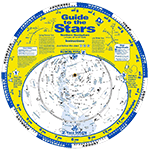|
2
|
Dwarf planet 1 Ceres at opposition at 4h UT. Mag. 7.6.
|
|
3
|
Mercury 1.7° NNE of Spica at 0h UT (14° from Sun, evening sky). Mags. −0.4 and 1.0.
|
|
4
|
International Observe the Moon Night
Join the global celebration: moon.nasa.gov/observe
|
|
6
|
Moon near Saturn at 1h UT (evening sky). Mag. 0.7.
|
|
7
|
Full Moon at 3:48 UT.
|
|
8
|
Comet C/2025 K1 (ATLAS) at perihelion. Mag. 9.4 (est.)
• C/2025 K1 (ATLAS) (Orbit & Observations)
|
|
8
|
Moon at perigee (closest to Earth) at 12:50 UT (distance 359,819km; angular size 33.2').
|
|
9
|
Pluto at southernmost declination (−23.5°) at 21h UT (evening sky). Mag. 14.5.
|
|
10
|
Moon near the Pleiades at 6h UT (morning sky).
|
|
12
|
Moon near M35 Cluster at 12h UT (morning sky).
|
|
13
|
Moon near Castor at 18h UT (morning sky).
|
|
13
|
Last Quarter Moon at 18:13 UT.
|
|
14
|
Moon near Pollux at 0h UT (morning sky).
|
|
14
|
Moon near Jupiter at 1h UT (morning sky). Mag. −2.2.
|
|
15
|
Moon near Beehive Cluster (M44) at 2h UT (morning sky).
|
|
16
|
Moon near Regulus at 19h UT (morning sky).
|
|
19
|
Moon near Venus at 19h UT (19° from Sun, morning sky). Mag. −3.9.
|
|
19
|
Mercury 2.0° SSW of Mars at 21h UT (22° from Sun, evening sky). Mags. −0.2 and 1.5.
|
|
20
|
Comet C/2025 R2 (SWAN) makes its closest approach to Earth (0.26 AU). Mag. 7.1 (est.)
• C/2025 R2 (SWAN) (Wikipedia)
• C/2025 R2 (SWAN) (Orbit & Observations)
|
|
21
|
Comet C/2025 A6 (Lemmon) makes its closest approach to Earth (0.60 AU). Mag. 3.2 (est.)
• C/2025 A6 (Lemmon) (Wikipedia)
• C/2025 A6 (Lemmon) (Orbit & Observations)
|
|
21
|
Orionid meteor shower peaks. Arises from the debris field of Comet Halley. Active from October 2 to November 7. Produces very fast (67 km/sec), generally faint meteors (10−20 per hour). Radiant located near Orion's club asterism.
• Orionids (Wikipedia)
• Orionids (American Meteor Society)
• 2025 Meteor Shower Calendar (PDF) (International Meteor Organization) |
|
21
|
New Moon at 12:25 UT. Start of lunation 1272.
|
|
23
|
Moon, Mercury and Mars within 4.3° circle at 11h UT (22° from Sun, evening sky). Mags. −0.2 and 1.5.
|
|
23
|
Moon near Mercury at 16h UT (23° from Sun, evening sky). Mag. −0.2
|
|
24
|
Moon at apogee (farthest from Earth) at 0h UT (distance 406,444km; angular size 29.4').
|
|
25
|
Moon near Antares at 2h UT (evening sky).
|
|
29
|
First Quarter Moon at 16:21 UT.
|
|
29
|
Interstellar Comet 3I/ATLAS at perihelion. Mag. 11.7 (est.)
• 3I/ATLAS (Wikipedia)
• 3I/ATLAS (Orbit & Observations)
|
|
29
|
Mercury at easternmost elongation at 22h UT (23.9° from Sun, evening sky). Mag. −0.1.
|
|
|
|
All times Universal Time (UT).
- US Eastern Daylight Time = UT − 4 hours.
- US Pacific Daylight Time = UT − 7 hours.
- Australian Eastern Standard Time = UT + 10 hours
- Singapore Standard Time = UT + 8 hours.
|







